More North Korean Artillery Troops Heading To Russia: Ukraine Intel Chief
The North Korean reinforcements will include gun and rocket artillery units and their hardware, as well as short-range ballistic missile capabilities.
HOWARD ALTMAN
POSTED 16 HOURS AGO
159
KCNA
Share
North Korea is expected to send reinforcements to
Russia’s Kursk region, Kyiv’s military intelligence chief told
The War Zone exclusively. It will mostly be missile and artillery troops who typically operate hundreds of tubed and rocket artillery systems as well as the
KN-23 short-range ballistic missiles Pyongyang has already provided Moscow, Lt. Gen. Kyrylo Budanov, head of Ukraine’s Defense Intelligence Directorate (GUR), told us. The artillery is being used to support both North Korean and Russian operations while the missiles are strictly for Russian objectives, he added, noting that the North Koreans will also train Russians on all of those systems.
“We don’t expect to see many new ground combat troops,” he posited. Ukrainian Special Operations Forces posted a video of its troops fighting North Koreans, which you can see in the following video.
Budanov’s comments add new details to
reporting by The New York Times on Wednesday that North Korean reinforcements are expected to arrive in Kursk “within the next two months,” according to an anonymous senior U.S. defense official. The publication did not say how many troops or what kind. The Ukrainian intelligence chief did not know for sure how many new troops would be coming or when they would arrive. So far, about a third of
the 12,000 North Koreans sent to Kursk have been killed, leaving about 8,000 to continue the fight, Budanov claimed. Those figures conform with
information provided yesterday by Ukrainian President Volodymyr Zelensky.
In contrast, the
BBC, citing Western officials,
reported that there were 4,000 battle casualties including wounded. About 1,000 were killed, the outlet stated.
The War Zone cannot independently verify either tally.
A photo shows an alleged North Korean soldier held after being captured by Ukrainian army on Jan. 11, 2025. Ukrainian President Volodymyr Zelensky said the country’s military had captured two North Korean soldiers in the Kursk region of Russia, adding that they had survived and were communicating with the Security Service of Ukraine. (Photo by Ukrainian President Volodymyr Zelensky’s Social Media / Handout/Anadolu via Getty Images) Anadolu
The new North Korean troops will boost Russia’s long-range fires in both Kursk and Ukraine, Budanov stated.
North Korea has provided about 120
170mm M1989 Koksan self-propelled artillery guns and 120
M-1991 240mm multiple launch rocket systems (MLRS) to Russia in the last three months, and will likely send at least as many more in the future, Budanov told us.
“They have a lot of these systems,” he added.
North Korea has an immense artillery arsenal it has built up over decades for use primarily along the DMZ should a war between North and South erupt. It has exported
millions of artillery rounds to Russia, which was in bad need of shells prior to the relationship between the two countries rapidly changing.
As we noted in our previous coverage, the Koksans feature a 170mm caliber artillery cannon, mounted in an open superstructure rather than a protected turret atop a chassis similar in appearance to that used on Russia’s
2S7 Pion, a 203mm self-propelled artillery piece. The M1989 version also has onboard storage for 12 rounds of ammunition. The weapon’s main advantage is its long range, with the big 170mm gun
assessed as capable of firing a standard shell to a range of around 25 miles, or a rocket-assisted shell to a range of 37 miles.
The M-1991s have 22 tubes aligned in two rows of eight and one row of six,
according to the U.S. Army. They have high explosive, smoke, incendiary, and chemical warhead capabilities within 200-pound warheads. These rockets also have a maximum range of about 37 miles.
Most of these weapons are either being used against troops in Ukraine or for training in Russia, Budanov noted.
“The 170mm weapons have powerful ammunition and good capability,” Budanov pointed out. “The 240mm MLRS are like any other heavy systems. They make more problems on the front line.”
M-1991 240mm multiple launch rocket systems (MLRS) like these on parade in Pyongyang, have been sent to Russia, according to Ukrainian intelligence. (KCNA)
In addition to the artillery, Pyongyang is expected to send 150 more
KN-23 short-range ballistic missiles to Moscow in 2025, said Budanov, adding that there were 148 sent last year. North Korean troops are firing those weapons from both the Kursk and Bryansk regions and will continue to instruct Russians, who are now firing them as well, Budanov stated. Those missiles,
as we previously reported, were first launched against Ukraine in January 2024, according to a Biden administration assessment at the time, with questionable results.
Russia has obtained the North Korean KN-23 short-range ballistic missile seen here. (North Korean State Media)
North Korean troops and weapons are adding to the challenges Ukraine faces both in Kursk and at home.
In Kursk, they are being used in so-called meat wave assaults, attacking in large numbers with little armor support,
according to The New York Times. Though differences in language and doctrine reduce their effectiveness, the sheer numbers of North Korean troops have forced Ukraine to expend munitions and defend positions they might not have had to otherwise.
Budanov, however, is not impressed with their capabilities.
“They are like biological robots,” he dismissed.
Despite fierce efforts by Russia and its North Korean allies to dislodge them, Ukraine
still holds onto its Kursk salient. Meanwhile, Russia continues to
slowly chew up ground in the eastern part of Ukraine, especially near the key logistical hub of Pokrovsk.
However, these advances are coming at
an extremely high price in terms of personnel and equipment. Since February 2022, Russia has suffered about one million troop deaths while Ukraine lost about 700,000, President Donald Trump said during a White House press conference.
As the fight slogs on, the new Trump administration has tasked special envoy Keith Kellogg, a retired Army lieutenant general, with
wrapping up the fighting in the next 100 days. That’s a questionable timeline especially given both Russian and Ukrainian objections to
publicly floated details from a plan co-written by Kellogg and published by the pro-Trump
America First Policy Institute. It calls for a delay in Ukraine joining NATO, freezing the front lines where they are, and suggests that the U.S. will boost its aid to Ukraine if Russia does not comply, while it will cut off aid if Ukraine does not. However, despite pledges he could quickly end this conflict, Trump has yet to release his peace plan.
Putin signaled that he was in
no rush to settle the war in Ukraine,
The Wall Street Journal reported on Wednesday. The goal of any coming talks “should not be a brief truce, not some kind of respite for the regrouping of forces and rearmament with a view to a subsequent continuation of the conflict, but a long-term peace based on respect for the legitimate interests of all people, all peoples who live in the region,” Putin said in a video released by the Kremlin this week, the publication noted.
Trump meanwhile, responded by criticizing the all-out invasion, saying Putin is “destroying Russia by not making a deal.” Responding to a reporter’s question about whether he would further sanction Russia if Putin refused to negotiate, Trump tersely said “sounds likely.” He went on to blame his predecessor, former President Joe Biden, for allowing the war to happen.
Trump expounded on his thoughts about dealing with Russia in a post on his Truth Social social media platform proffering that if Putin doesn’t stop the war in Ukraine, he will impose tariffs and sanctions on Russia “and various other participating countries” — a likely nod to Iran, North Korea and China.
The looming addition of fresh North Korean troops and weapons further complicates any peace negotiations, giving Putin extra resources to continue the war.
Contact the author: [email protected] 



 ...
...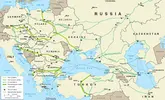
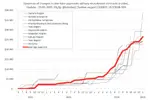
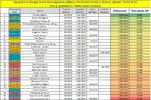
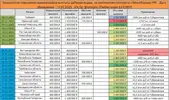




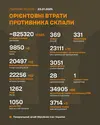

 Tilanne Velika Novosilkan asutuksen ympärillä.
Tilanne Velika Novosilkan asutuksen ympärillä. Johto toteuttaa toimia yksiköiden vahvistamiseksi, taisteluvälineiden toimittamiseksi, sivustojen turvaamiseksi ja vahvistamiseksi. Lisäksi on suunniteltu toimenpiteitä taktisessa tilanteessa tapahtuviin kärjistyksiin ja sen mahdolliseen kehitykseen varautumiseksi.
Johto toteuttaa toimia yksiköiden vahvistamiseksi, taisteluvälineiden toimittamiseksi, sivustojen turvaamiseksi ja vahvistamiseksi. Lisäksi on suunniteltu toimenpiteitä taktisessa tilanteessa tapahtuviin kärjistyksiin ja sen mahdolliseen kehitykseen varautumiseksi. Taistelutoimien mukana kulkee myös informaatiosota. Raskaiden taisteluiden, henkilöstötappioiden ja sodan nopean dynamiikan keskellä vihollinen tehostaa psykologista vaikuttamistaan sekä etulinjan sotilaisiin että koko Ukrainan yhteiskuntaan. Venäläisten propagandistien päätavoite on horjuttaa yhteiskunnan mielialoja, luoda hämmennystä ja heikentää luottamusta sotilasjohtoon ja Puolustusvoimiin. Tällä pyritään laskemaan Ukrainan puolustajien moraalia ja edistämään vihollisen hyökkäystoimia. Vihollinen käyttää informaatiota aseena, peittäen lähteensä taitavasti.
Taistelutoimien mukana kulkee myös informaatiosota. Raskaiden taisteluiden, henkilöstötappioiden ja sodan nopean dynamiikan keskellä vihollinen tehostaa psykologista vaikuttamistaan sekä etulinjan sotilaisiin että koko Ukrainan yhteiskuntaan. Venäläisten propagandistien päätavoite on horjuttaa yhteiskunnan mielialoja, luoda hämmennystä ja heikentää luottamusta sotilasjohtoon ja Puolustusvoimiin. Tällä pyritään laskemaan Ukrainan puolustajien moraalia ja edistämään vihollisen hyökkäystoimia. Vihollinen käyttää informaatiota aseena, peittäen lähteensä taitavasti. Pyydämme noudattamaan informaatiokriittisyyttä, arvioimaan tilannetta huolellisesti ja jatkamaan Ukrainan asevoimien tukemista. Heidän varassaan lepää valtion olemassaolo.
Pyydämme noudattamaan informaatiokriittisyyttä, arvioimaan tilannetta huolellisesti ja jatkamaan Ukrainan asevoimien tukemista. Heidän varassaan lepää valtion olemassaolo.



 Tilanne Velika Novosilkan ympärillä
Tilanne Velika Novosilkan ympärillä ️ Osa vihollisjoukosta saadaan eliminoitua jo tässä vaiheessa, mutta vihollisen joukkojen määrä mahdollistaa etenemisen. Kun he pääsevät taloihin, taistelu muuttuu.
️ Osa vihollisjoukosta saadaan eliminoitua jo tässä vaiheessa, mutta vihollisen joukkojen määrä mahdollistaa etenemisen. Kun he pääsevät taloihin, taistelu muuttuu. Ihminen. Koordinaattien laskenta, tuuli, kosteus, ampujien kokemus ja ammattitaito.
Ihminen. Koordinaattien laskenta, tuuli, kosteus, ampujien kokemus ja ammattitaito. Talojen puhdistaminen ja vihollisen pysäyttäminen tällaisissa taisteluissa on nimenomaan jalkaväen ja rynnäkköjoukkojen tehtävä. Päivän aikana eliminoimme prikaatin voimin enemmän vihollisia kuin joissain omissa pataljoonissamme on enää miehistöä jäljellä.
Talojen puhdistaminen ja vihollisen pysäyttäminen tällaisissa taisteluissa on nimenomaan jalkaväen ja rynnäkköjoukkojen tehtävä. Päivän aikana eliminoimme prikaatin voimin enemmän vihollisia kuin joissain omissa pataljoonissamme on enää miehistöä jäljellä.

